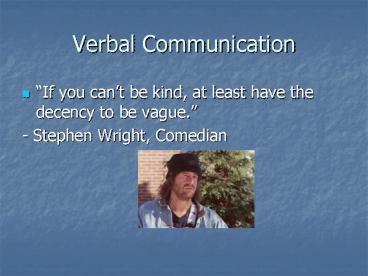Verbal Communication PowerPoint PPT Presentation
1 / 29
Title: Verbal Communication
1
Verbal Communication
- If you cant be kind, at least have the decency
to be vague. - - Stephen Wright, Comedian
2
Verbal Communication
- The real art of conversation is not only to say
the right thing at the right time, but also to
leave unsaid the wrong thing at the tempting
moment. - - Stephen Wright, Comedian
3
Verbal Messages
- When I use a word, Humpty Dumpty said in
rather a scornful tone, it means just what I
choose it to mean neither more nor less. - - Lewis Carroll
4
Power of Language
- Language symbolizes reality.
- How we use it affects how we see reality and how
we communicate.
5
Language Symbolizes Reality
- Intensional Orientation
- Already made file folder.
- Labels First, Actual Second.
- Map is more important than territory
- Over-Dependence on definitions, verbalizations,
etc.
6
Intensional Orientation
- Viewing people, objects, and events how they are
talked about or labeled rather than how they
actually exist. - Map is more important than the territory.
7
Intensional Orientation
- Often leads to Stereotypes
- Kelly is a female so she must be nurse.
- Guys that wear Yankees hats are jerks.
8
Extensional Orientation
- Make a new file folder.
- Looking at the actual people, objects, and events
first, and then at the labels. - The territory is more important than the map.
- To view first without label.
9
Allness
- Six Blind Men and the Elephant
- Don judge whole by a part
- Wall, spear, snake, tree, fan, rope
10
Nonallness Attitude
- To be conscious that you are ignorant is a great
step toward knowledge. - - Benjamin Disarelli, former British Prime
Minister
11
Flawed Perception
- We often treat inferences as though they are
facts. - Everybody knows that
12
Facts
- Made after observation and limited to what is
observed.
13
Facts
- Made Only After Observation
- Limited to What Has Been Observed
- Made Only by Observer
- About Past or Present
- Approach Certainty
- Subject to Verifiable Standards
14
Inferences
- Can be made by anyone at anytime and is not
limited to what is observed.
15
Inferences
- Made At Any Time
- Go Beyond What is Observed
- Made by Anyone
- May Be About Past, Present, or Future
- Vary in Probability
- Not Subject to Verifiable Standards
16
Language Expresses Both Facts and Inferences
- Problems arise because we often act as though
inferences are facts. - We all know this is how it works
17
Denotation and Connotation
- Denotation the objective definition of a word a
general or universal meaning. - Connotation the subjective or emotional meaning
of a word a personal and less precise meaning. - Snarl Words
- Purr Words
18
Language can criticize and praise
- An important interpersonal skill is to detect
when a person is asking for criticism versus a
compliment.
19
Expressing Praise
- I language.
- Communicate positive feelings (nonverbal match).
- Name the behavior youre praising.
- Consider culture.
- No That was good.
- Yes I thought your introduction was great.
20
Criticism
- Focus on the event or behavior, not personality.
- Be specific.
- State criticism positively.
- Own your thoughts and feelings.
21
Which is More Effective?
- Your paper is weak.
- I think the introduction isnt clear enough.
Perhaps a specific statement of purpose would
have worked better.
22
Which is More Effective?
- Dont you care about the impression you make?
This report is terrible. - I think I would use a stronger introduction and
a friendlier writing style.
23
Language can obscure distinctions
- Indiscrimination occurs when you focus on a
class of individuals, objects, or events and fail
to see the uniqueness of the individual.
24
Ethnocentrism
- Evaluating the values, beliefs, and behaviors of
your own culture as being more positive, logical,
and natural than those of other cultures. - Usually done on a continuum.
25
Polarization
- A black and white view of the world.
- Describing the world in extremes.
26
Correcting Polarization
- Most cases fall between extremes.
- Middle terms.
27
Static Evaluation
- Retaining evaluations without change even though
the reality has changed.
28
Confirmation and Disconfirmation
- Confirmation communication patterns that
acknowledges the presence of other people and
show acceptance. Boosts self esteem. - Disconfirmation Ignore other peoples presence,
showing rejection. Lowers self esteem.
29
Verbal Communication Summary
- Extensional Orientation is more effective.
- Dont treat inferences as though they are facts.
- Recognize the difference between connotation and
denotation. - Expressing praise and criticism requires planning
and precision. - Be careful with polarization language.

